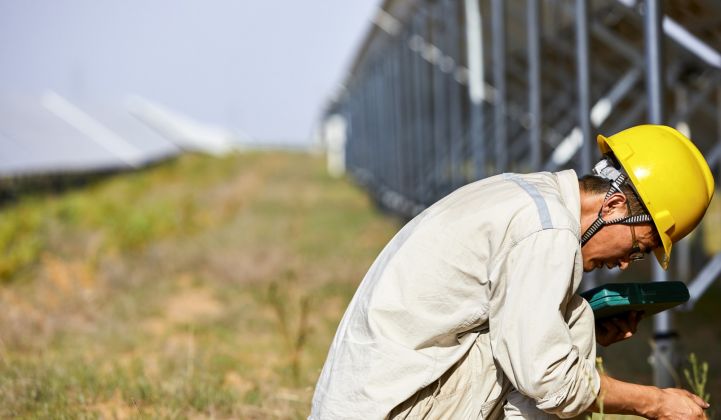China is aiming to get renewables off of subsidies after capacity additions in 2017 left the administration facing a 110 billion yuan (USD $16.3 billion) payment backlog.
The cash shortfall, reported by the Chinese National Development and Reform Commission’s Energy Research Institute, forced the government to suspend all new subsidized solar capacity approvals from May 2018.
This month, amid speculation that subsidies will be phased out from the end of 2020, the Chinese National Energy Administration (NEA) released a package of enticements for developers willing to bet on subsidy-free solar and wind projects over the next two years.
“With the large-scale development of wind power and photovoltaic power generation and the rapid advancement of technology, in areas with good resources, low construction costs, and good investment and market conditions, the conditions for the on-grid parity of coal-fired benchmarks (excluding state subsidies) are basically met,” the NEA said in a statement (translated to English).
To force moves in that direction, the government decreed last spring that projects would be awarded on an auction basis with subsidy levels acting like a cap. The subsidies range from ¥0.4 to ¥0.57 ($0.06 to $0.08) per kilowatt-hour, depending on what region the project is in.
Still, China’s energy regulators know it won’t be easy to get developers to move away from subsidies altogether.
Hence, the zero-subsidy offer comes with a generous package of eight inducements to help pave the way for a smooth transition toward grid-parity wind and solar after 2020, according to Feng Zhao, an independent wind energy analyst. Here is what’s included.
1) Long-term contracts
Any developer offering to sell energy at grid parity or less from projects approved in the current regulatory period can get a 20-year government offtake agreement.
2) Full acquisition of renewable generation
Curtailment is a major issue for Chinese renewable energy developers. For wind farm developers, curtailment amounted to a loss of 16 percent of all generation between 2010 and 2016.
To avoid this, zero-subsidy wind and solar farms will be able to convert curtailment losses into a “prioritized generation right” that can be traded on the open market.
3) Lower nontechnical costs
The new package will prevent local governments from charging unfair prices for the land used for zero-subsidy renewable energy projects.
Regional administrations are also being asked to waive any local content requirements for renewable energy procurement on zero-subsidy projects.
4) Guaranteed grid connections
A big problem for subsidy-based projects in northern China is that they sometimes get built faster than the grid connections they need. With zero-subsidy plants, the local transmission system operator will be obliged to put a grid link in place by the time the project is commissioned.
5) Lower transmission fees
Currently, renewable energy projects have to pay tier-based fees for transmission capacity, meaning those at the bottom of each tier pay over the odds. The new package reduces transmission fees for projects selling energy directly to end users nearby.
Distributed renewable project demos, meanwhile, will only have to pay for the transmission capacity they use in practice.
6) Financial support
China’s four state-owned commercial banks and Chinese development banks will be required to arrange loans and develop financial products to support zero-subsidy plants.
7) Exemption from energy consumption targets
Every year, the Chinese government conducts a total energy consumption evaluation of each province, to try to curb emissions and pollution. But renewable power is exempted from the evaluation, said Zhao, so regional planners might be more willing to consider renewables as a way of meeting growing electricity demand.
8) Green certificate scheme eligibility
Zero-subsidy wind and solar farms will be automatically eligible for a green certificate scheme the government has been mulling for some time. The exact schedule for launch of this mandatory scheme is still uncertain, but is unlikely to stretch beyond 2019, said Zhao.
Industry response
It's too early to gauge developer reaction to the package, but responses so far have been positive.
The China Photovoltaic Industry Association, which represents equipment manufacturers, said in a statement that the new policy is “good news” for the struggling sector, according to Reuters.
Solar stocks tumbled last year following the announcement suspending new subsidized projects. Meanwhile, some solar projects in northwestern China continue to suffer from high transmission costs, delays in subsidy payments, and insufficient purchases from grid companies.
In this context, the NEA’s subsidy-free renewables program is a welcome new offering for the solar sector.
Zhao echoed the sentiment that the NEA’s plan could prove popular for China’s wind sector.
“I saw some comment both from the banks and large developers in China,” he said. “They said some projects under this new scheme could be more competitive [than] projects where they still have the feed-in tariff.”
The main driver for wind installations over the next two years, though, is likely to be a rush to build projects that were approved by the NEA before the end of 2018. Developers must start building these projects this year if they want to benefit from a previous, higher-level FIT that ranged from ¥0.47 to ¥0.6 ($0.07 to $0.09) per kilowatt-hour.
Because of this, said Zhao, FTI Consulting is expecting to see around 25 gigawatts of new wind power annually in China this year and next, up from around 20 gigawatts in 2018.
Xiaoyang Li, a senior consultant at Wood Mackenzie, confirmed the zero-subsidy policy “may give a potential upside for China's near-term wind power outlook.”
However, she added, given the scale of China’s renewable energy ambitions, it is still far from certain whether FITs will be eliminated completely in the country, even after 2020. “It is unlikely the subsidy will disappear completely by then,” she said.
“Besides, the target is focused on onshore wind,” she said. “Offshore wind power will continue to receive subsidy support in the near to mid-term.”




